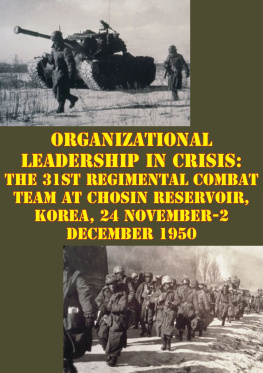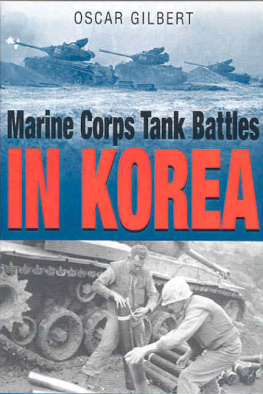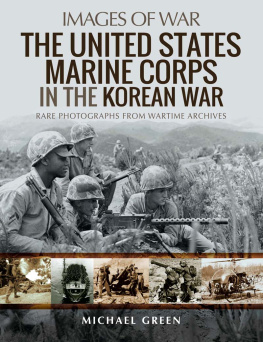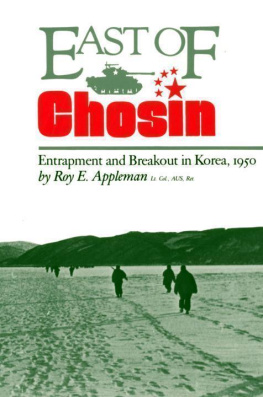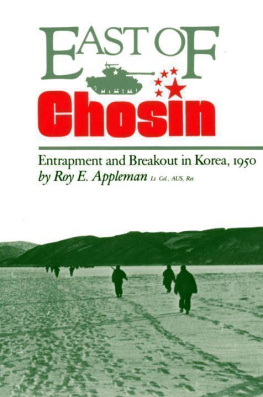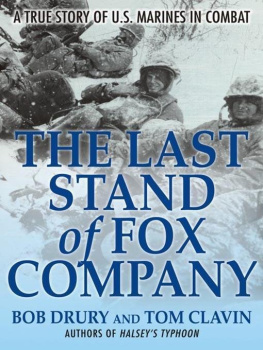William B. Hopkins
One Bugle, No Drums
The Marines at Chosin Reservoir
Algonquin Books of Chapel Hill
Contents
List of Maps and Illustrations
MAPS
ILLUSTRATIONS
Preface
December 10, 1950, was a very sad day. Yet as I stood on the mountainside and watched the men of the 1st Marine Division move downhill to safety after being surrounded by Chinese Communist soldiers for the better part of two weeks, it was a day of relief. The Chosin Reservoir Campaign was over. Many years have passed since then, and in the minds of the American public it is all but forgotten. But what I saw there is no less vivid to me today than the actual event was. And when I reflect on what happened, my emotions are substantially the same.
Later in the 1950s, I visited my regimental commander, Lieutenant General Lewis K. Chesty Puller, by then retired. He insisted that the 1st Marine Division at the frozen Chosin Reservoir was the finest fighting force ever. This view from Americas most decorated soldier had support from S. L. A. Marshall, noted United States Army historian who, in an indepth study of that campaign said, No other operation in the American book of war quite compares with this show by the 1st Marine Division in the perfection of factual concepts precisely executed, in accuracy of estimate of situation by leadership at all levels and in promptness of utilization of all supporting forces.
Outside the U.S. Marine Corps few will know why one of our nations finest military historians would proclaim the 1st Marine Divisions performance in northeast Korea as probably the greatest ever. Under the harshest conditions ever encountered by American troopsany place, any timeMarines faced an enemy force of twelve Chinese Communist divisions, or approximately 100,000 men, twice the size of the British Army at its peak strength during the American Revolutionary War. They inflicted greater casualties on the enemy than did the Continental Army in its eight-year fight for our independence. Why such a difference? Americas superior technical know-how was placed in the hands of properly trained, disciplined soldiers. These soldiers were made to appreciate the dignity of the civilian population, the most important factor in a limited war.
The poorly equipped Chinese Army relied primarily on World War I-vintage arms, but time-honored fighting methods. Its ill-provided soldiers routed our U.S. 8th Army, which enjoyed superior firepower and was far better supplied. The victory marked a changing tide in the political affairs in Asia. Communist China emerged as the major military power among Asian states.
The Chosin Reservoir Campaign stands out as a model military action. In contrast with the performance of the 8th Army, the 1st Marine Division successfully fended off an enemy force many times its size. The reasons for its success were not fully examined by our nations leaders at the time; neither was the defeat of the 8th Army. Today, thirty-six years later, this story of success and failure is still not comprehended by the great majority of literate Americans. To understand better the art and science of modern war and its inseparable relationship to the political structure, our political and military leaders should address themselves to the unfinished business of Korea.
During most of the campaign, the Marines fought an orderly retreat from the mountains of north-central Korea to the sea. I witnessed the fighting from the vantage point of Company Commander, H&S Company, 1st Battalion, 1st Marineswhich we called, the 1st of the 1st of the 1st. From our division commander, Major General O. P. Smith, down through the ranks, leadership excelled at every level. But the solution to coping with the Chinese mass can be found in the oftentimes overlooked fighting mans performance.
Historians write about wars, battles, and generals who lead. In a ground war, most of the fighting is done at the company level and below, by privates, corporals, sergeants, lieutenants, and captains. When an officer is promoted to major, he becomes less the fighter and more the executive. The general in charge is the chief executive officerthe chief decision maker. He may once have been a fighteror he may not have been. Historians refer to generals as fighters, while with the passage of time the real fighters become mere statistics in the history books. Nonetheless, it is the strength and character of these statistics that shoulder the heaviest burden for success in battle.
The fighting men of the 1st Marine Division were almost evenly divided between Regulars and Reserves, the Reserves coming from 124 selected cities across the nationRoanoke, Virginia, being one. As the commanding officer of the Roanoke Unit, I had supervised its training prior to its dispersion from the West Coast to Korea.
This story is one of fact. There are no fictional events. All persons are real, although the names of some minor characters have been omitted. The dialogue is based on fact.
Acknowledgments
I wish to thank my friend the late Perry F. Kendig, a former president of Roanoke College, who encouraged me to write this book. In the early stages he helped me develop a style of writing. He warned, nobody will read a book that reads like it was written by a lawyer.
I thank those who read one or more revisions of my manuscript and gave critical comments, namely: Harold Sugg, Robert Fishburn, Cy Bunting, Bill Bagbey, and Cecil Edmunds. Cecil was also instrumental in selecting the books title.
Thanks are due Frank Kerr, the founder and first president of The Chosin Few, for his help in securing the many pictures displayed in this book.
Special thanks are due Gen. Robert H. Barrow, USMC (Ret.), who graciously allowed me to use his unpublished version of the Battle of the Big Hill, and who, together with Col. Wesley Noren, USMC (Ret.), Lt. Col. Don Jones, USMC (Ret.), and Major James C. Adair, USMC (Ret.), contributed to the narrative. Col. David W. Bridges, USMC, now deceased, was also a major contributor.
I wish to thank the personnel at the History Division, Headquarters, Marine Corps; General Douglas A. MacArthur Memorial Archives; Center of Military History, U.S. Army; George C. Marshall Memorial Library; Institute of Military History, U.S. Army; and History Division, Boiling Air Force Base. All were very courteous and most helpful.
I wish to thank Professor Harold Hill, head of Chinese Studies, Washington and Lee University, for his assistance in translating the Great Resist America and Aid Korea Movement, composed by the Peoples Republic Congress, which was checked out of the Asian Division of the Library of Congress. However, the contents of this book proved to be disappointing in that the book seemed to be a compilation of Communist China propaganda broadcasts, most of which could be found in the Foreign Broadcast Information Service Daily Reports.
Thanks are due Steven Rhodes, who assisted in revising my original manuscript; Virginia Ann Fowler and Sarah Christensen Cox, for their assistance in the preparation and typing of my first rough draft; and Belle Wyatt.
Special thanks are due Janet Holt Johnstone, my editor.
1
Return to War
The powdery falling snow was the driest I had ever seen, the temperature of five degrees below zero Fahrenheit made almost unbearable by icy winds. At 0500 on December 8, 1950, it was dark, very dark, in the Chosin Reservoir country of North Korea. Snow usually brightens the landscape, even at night, but there was no light here to reflect against its white surface. Even so the piercing, bone-chilling cold failed to prevent us from moving up the mountainside. The 1st Battalion, 1st Marines, walked and climbed in silence. Snow muffled the sound of footsteps. Occasionally a cough or a mans fall broke the quiet, but not often.
Next page


